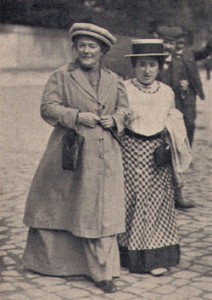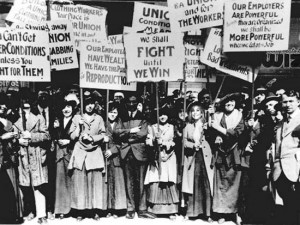 International Women’s Day is celebrated on March 8 worldwide. United Nations has officially made it a women holiday as well, and in various states, it is being celebrated as a national holiday. March 8 is considered to be an internationally recognized day of women, celebrating their advancements and achievements in various spheres (political, economic or social). This day is meant to be seen as a day of struggle for the roles and rights in the social life, which was fought for in the past, the basis for which was instigated by feminist women.
International Women’s Day is celebrated on March 8 worldwide. United Nations has officially made it a women holiday as well, and in various states, it is being celebrated as a national holiday. March 8 is considered to be an internationally recognized day of women, celebrating their advancements and achievements in various spheres (political, economic or social). This day is meant to be seen as a day of struggle for the roles and rights in the social life, which was fought for in the past, the basis for which was instigated by feminist women.
The International Women’s Day is the history of the fight of the ordinary women. It is a day telling about the struggles women faced in obtaining equal rights with men, similar working conditions as well as for ensuring active participation to social life.
On this day, women of various nationalities, ethnicities and religions, regardless of their linguistic, cultural features and/or political views, unite to celebrate the day of the woman struggling for equality, justice and peace for over nine decades.
Over the years, the International Women’s Day has grown into a large movement from closed discussions, and has been moved to streets by including revolutionary currents. It has seen the opposition of various political figures and intellectuals, it has knocked the doors of various political and social institutions, it has traveled from state to state pursuing the aim of changing the role of women in societies, and defending the illegally violated and ignored rights of women through legal fight. It also aimed in making the voice of women heard, by struggling against the gender inequality existing in many areas of life.
The historical roots behind the International Women’s Day date back to 1910, when it was first celebrated internationally, and socialist women of the Unites States had already managed to organize the first National Day of Women in 1908, by setting a foundation for the future international holiday.
Thinking about the International Women’s Day nowadays, we perceive and celebrate it as a day of inputs, achievements and advances of women in various domains of life, while, meanwhile, we should not forget in what kind of harsh times and bitter events it was born, as a result of the confrontations and outbreaks of the working class in the beginning of 20th century.
International Women’s Day was perceived as women’s holiday since 1900s, when the industrial world was involved in new economic development; big turmoil and changes, when the overgrowth of population and the first germs of radical ideology were first witnessed.

Clara Zetkin, the founder of Women’s International Day (on the left), with her friend Rosa Luxembourg.
Yes! The International Women’s Day was born in conditions of social convulsion and social crisis, therefore inheriting all the features of civic activism and outcry. It is to be mentioned that the working conditions and wages were terrible for women back then (the beginning of the 20th century until 1910). It was only a handful of women, in few industrially developed countries, who could afford having a job with reasonable salary. In any case, any kind of workplace for women was segregated, based on gender peculiarities. It is to say that women only had to work in workshops and factories dealing with manufacturing, textile and other household services, where the conditions were horrible and the salary was even worse. All of this was a base for further advancement. In 1908, oppression against women and severe gender inequality in different spheres of life raised a wave of dissatisfaction among working women in USA, by making them more determined in fighting against the violation of their rights, violence and discrimination based on gender. It also made them strong-minded in uttering their so-often-silenced voice and in alarming about gender equality, and in becoming more active, socially and politically. That same year, 15.000 women marched through the central streets of New York, fighting for better working hours, salary necessary for welfare life, and more importantly: the right to vote.
According to the statement made by the Socialist Party of America, February 28th was the primary date to be marked as the International Day of Women’s Rights all around the United States, and until the end of the year of 1913, women were celebrating that day on the last Sunday of February. During the Second International Conference of Working Women held in Copenhagen in the capital city of Denmark in 1910, Clara Zetkin, of German origin, who was the head of the “Women’s Office” of Social Democratic Party of Germany, tabled celebrating International Women’s Day as an annual holiday. She suggested establishing a specific day all over the world as an international holiday for women that would incorporate the whole ideological essence of the women’s rights protection. More than 100 women from 17 various countries were participating in the conference, presenting diverse unions, socialist parties, and clubs of working women. Three women that were chosen as members of Finnish parliament were also present. All the women unanimously accepted Zetkin’s proposition, and the Day of Women became an internationally celebrated holiday.
After the decision of 1910, the International Women’s Day was first celebrated on March 19 in Austria, Denmark, Germany and Switzerland. More than a million women and men were participating in marches and campaigns on the occasion of International Women’s Day. These campaigns intended in helping women work, to vote, get education, holding the right to obtain positions in the social and political sphere, rights protection as well as eliminating gender based discrimination.
Next, in 1913, Russian women started celebrating their International Women’s Day on the last Sunday of February (according to the Julian calendar used in Russia at that time). As a result of discussions, the holiday was shifted on March 8 that same year, becoming an internationally celebrated day since it was recognized worldwide by various states.
 In the former USSR territory, March 8 was regarded as a working day until 1965, but that same year, on May 8, according to the order of the Supreme Council of the USSR, the International Women’s Day was proclaimed a non-working day, in honor of the contributions and inputs of women of Soviet Union in developing communist structure, for the bravery in protecting the fatherland during the Great Patriotic War, as well as strengthening comradeship and peace among peoples of Soviet Union.
In the former USSR territory, March 8 was regarded as a working day until 1965, but that same year, on May 8, according to the order of the Supreme Council of the USSR, the International Women’s Day was proclaimed a non-working day, in honor of the contributions and inputs of women of Soviet Union in developing communist structure, for the bravery in protecting the fatherland during the Great Patriotic War, as well as strengthening comradeship and peace among peoples of Soviet Union.
Just after the official recognition of the International Women’s Day in USSR, it spread throughout the territory of former USSR, the holiday was also celebrated in other Soviet and Socialist states, too, including Chinese communists starting in 1922 and the Spanish since 1936.
And in the West, the International Women’s Day has been regarded as a nationwide event starting from 1977, when, according to the decision of General Assembly of UN, March 8 was proclaimed, “United Nations (UN) Day for Women’s Rights and International Peace”. In fact, the Charter of the UN signed in 1945 is the first internationally recognized convention which includes gender equality as a basic human right.
The theme and the motto of the International Women’s Day of UN of this year is: “Empower Rural Women–End Hunger and Poverty”.
After the collapse of the Soviet Union, the newly independent Republic of Armenia had officially ceased the celebrations of March 8 for the International Women’s Day, and April 7th was intended to be celebrated as the day of Motherhood and Beauty, as a new holiday recognized by the state which quickly spread among Armenians, also because of being one of the main holidays of Armenian Apostolic Church – Annunciation. People were nevertheless loyal to the old Day, March 8, and public voting resulted in having two holidays dedicated to women, and the period between March 8 and April 7 was announced as Women’s Month.
Nelly Paitian
Sources:
http://www.un.org/ecosocdev/geninfo/women/womday97.htm
http://www.isis.aust.com/iwd/
http://www.internationalwomensday.com/
http://www.internationalwomensday.org.au/
http://www.cbc.ca/news/world/story/2011/03/08/f-womens-day-history.html



